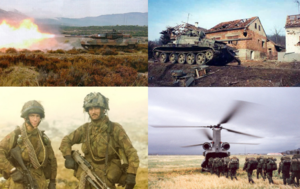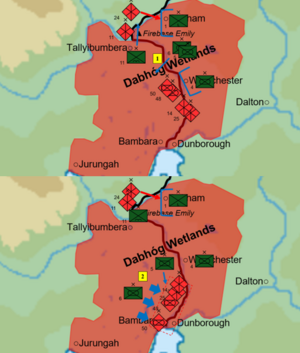Battle of Westchester
| Battle of Westchester | |||||||
|---|---|---|---|---|---|---|---|
| Part of Telekonese Conflict | |||||||
 Photos from the Battle of Westchester (clockwise form Top Left): A tank from the Royal Arcerion Dragoons engages a Kelekonese target; a destroyed Kelekonese main battle tank on a road outside Bambara, Infantrymen from the Arcerion Parachute Regiment load up to reinforce the airhead at Tallyibumbera Airfield; Two soldiers from the Northlea Rifle Regiment pose for a photo outside of Bambara, Kelekona. | |||||||
| |||||||
| Belligerents | |||||||
|
|
| ||||||
| Commanders and leaders | |||||||
| Colonel Dean Griffith | Major-General Molor T't-yrosha | ||||||
| Units involved | |||||||
|
4 Mechanized Brigade 5 Mechanized Brigade 6 Mechanized Brigade Arcerion Special Operations Command (various) |
48th Mechanized Brigade (NG) 50th Mechanized Brigade (NG) 14th Motor Rifle Brigade 25th Motor Rifle Brigade | ||||||
| Strength | |||||||
| 3 Mechanized Brigades (-), est. ~9,900 | 2 Mechanized Brigades, 2 Motorized Brigades, est. +14,000 | ||||||
| Casualties and losses | |||||||
|
22 KIA 78 WIA ~53 armoured vehicles damaged/destroyed |
Unknown, estimated ~1,000 KIA +400 armoured vehicles destroyed | ||||||
The Battle of Westchester (12-13 October 1991) was one of the final engagements of the 1991 Telekonese Conflict between Arcerion and Kelekona. Part of the larger Operation Corbray, the Battle of Westchester was a large mechanized counter-offensive to relieve the beleaguered 4 Mechanized Brigade Group defending the town after which the battle is named.
Background
Around the town of Westchester, the subordinate units to 4 Mechanized Brigade had conducted a tough defensive fight against four Kelekonan brigades, attempting to delay their push across the Innis River and into the Arcer Heartland. Working closely with engineers, the Northlea Rifle Regiment and the Royal Arcerion Regiment had dug themselves into the town's outer boroughs and suburbs, and utilizing anti-tank guided missiles (ATGMs) and new infantry anti-tank weapons, they delayed Kelekonan troops with the use of minefields, prepared fighting positions, and anti-tank obstacles. Kelekonan forces suffered from poor morale and coordination, and their inability to use engineers, combined with accurate Arco artillery fire meant progress to conduct the river crossing was extremely slow. As of September, air strikes and the defensive line had slowed the offensive and the Arcer General Staff were prepared to begin the counter-offensive, Operation Corbray.
To the North, 11 Parachute Brigade conducted a sudden seizure of the Kelekonan forward airfield at Tallyibumbera, and outflanked the Kelekonan 11th Motor Rifle Brigade. Without close air support, many of their aircraft damaged, and one of their main brigades caught out of position, Kelekonan senior officers ordered the 11th Motor Rifle to pivot and withdraw towards friendly lines to the Northwest.
Preparations had been undertaken by 5 and 6 Mechanized Brigades, which had been kept as an operational reserve, and placed under the commander of Colonel Dean Griffith. Preparations began in the last week of September, and Griffith received a warning order from the Arcer General Staff to conduct offensive operations along the Westchester axis and relieve pressure on 4 Mechanized Brigade. Outnumbered, Griffith worked with liaison officers from Arcerion Special Operations Command and the Arcer Air Force to conduct air strikes and deep reconnaissance of Kelekonan lines and rear areas. With preparations made, preparatory bombings and precision long range strikes using cruise missiles (some fired by submarines from the Royal Arcerion Naval Service) and rockets began, destroying command and control nodes, logistics facilities, and troop concentrations on 10 and 11 October.
Battle
On the night of 12 October, at 2330 local time, the forward deployed elements of 5 and 6 Mechanized Brigades conducted a counter-attack around the Northern flank of the Westchester area of operations. After a successful bridge laying by the Arcerion Combat Engineer Regiment, main battle tank squadrons, utilizing modern night fighting equipment and GPS-positioning systems began to engage the 50th Mechanized Brigade's outer elements. The Arco units had new thermal imaging systems, and many Kelekonan troops ran their vehicles at night to stay warm as their officers did not permit the lighting of fires, and these were easily picked off by Arco main battle tanks and LAVs. 5 Mechanized Brigade quickly fixed their adversaries in place, and over the next few hours destroyed much of the 501st and 502nd Mechanized Infantry Regiments. The Kelekonans withdrew the remaining elements of the 500th Armoured Regiment and the remaining infantry they had South, in a panicked road move under night conditions. Reconnaissance drones assisted 6 Mechanized Brigade, which had continued the flank further Southwest, and caught much of the 50th Mechanized as they attempted to link up with the 48th Mechanized Brigade. Lacking in heavy tanks, 6 Mechanized used ATGMs and air strikes from the Arcer Air Force to destroy much of the 500th Armoured Regiment of the Kelekonan Army along the roadway, forcing the 48th to conduct a failed coutner-attack at 0400, which was quickly rebuffed by the Arcerion Mounted Rifles.
By morning, the 48th Mechanized had begun a withdraw to the West in the direction of Bambara. With their flanks exposed, the 14th and 25 Motor Rifle Brigade attempted to conduct a counter-attack to delay 5 Mechanized's main battle tanks from cutting them off from Kelekonan lines of communication. This attack failed, with the 1401st Motor Rifle Regiment being completely destroyed by 1 Arcerion Tank Regiment, resulting in dozens of Kelekonan armoured vehicles being lost and hundreds of dead and wounded. With the technological advantage in GPS allowing for Arcer higher command at Griffith's forward command post to effectively track the battle throughout the night, the battle was concluded in the waning hours of October 13th. The 14th Motor Rifle Brigade had conducted a hasty withdrawal towards Bambara, pursued aggressively by anti-tank LAVs and reconnaissance vehicles from the Arcerion Mounted Rifles, leaving the 25th Motor Rifle little choice but to dig in and defend its positions at the Southern edge of the Westchester area of operations. Rainy roads and highways packed with civilian traffic had made the remaining Kelekonan forces' retreat towards Bambara extremely difficult, and combined with laser-designated air strikes by members of the Special Arcerion Service Regiment, the Kelekonan troops struggled to outpace 6 Mechanized Brigade.

Aftermath
Kelekonan forces had managed to withdraw close to Bambara, however they had continued to be harassed and hunted by 5 and 6 Mechanized Brigades, with their sub units and logistical elements spread out between the Arco-Kelekonese border and Bambara. Griffith's battlegroup had effectively put most of these forces in a cauldron, with one side being the Malentine Sea, the bottom being the Innis River, the Northern Edge 5 and 6 Mechanized Brigades, and the quickly closing open portion towards Bambara was constantly harassed by Arco artillery, air power, and civilians fleeing the fighting.
On 5 November, Arcerion accepted an invitation by the United Republic of Alstin to conduct talks with Kelekona for an armistice, and Arco troops withdrew for the next several days back to the Eastern side of the Innis river in sovereign Arcerion. The result of the armistice created a demilitarized zone along the Kelekonan side of the border with Arcerion. The battle's decisive role in destroying much of Kelekona's professional army, liberating Arcer territory, relieving 4 Mechanized Brigade, and decidedly turning the war in Arcerion's favour highlighted the advancements that had been made by the Arcer Army.
The battle today is still studied at Royal Arcer Military College during courses on warfare and military history, and the Battle's anniversary is celebrated by both the Arcerion Armoured Corps and the Arcerion Tank Regiment. It remained the largest armoured battle in Crona since the Second Great War until the outbreak of hostilities with Varshan during the Final War of the Deluge.